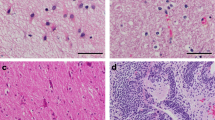Abstract
The distribution and organization of nerve cells in a microcerebellum and cerebellar stalk, developed within the matrix of a mature ovarian teratoma, were analyzed with respect to recent data on cerebellar histogenesis. It is postulated that a neuroectodermal germinal locus with proliferation capability similar to that found in the alar plates of the normal embryonic rhombencephalon was responsible for the formation of this highly organized neural tissue.
Similar content being viewed by others
References
Altman J (1969) Autoradiographic and histological studies of postnatal neurogenesis. III. Dating the time of production and onset of differentiation of cerebellar microneurons in rats. J Comp Neurol 136:269–294
Altman J (1972) Postnatal development of the cerebellar cortex in the rat. J Comp Neurol 145:353–514
Altman J, Bayer SA (1985) Embryonic development of the rat cerebellum. J Comp Neurol 231:1–65
Caviness VS, Rakic P (1978) Mechanisms of cortical development: a review from mutations in mice. Ann Rev Neurosci 1:297–326
Caviness VS, Williams RS (1985) Cellular patterns in developmental malformations of neocortex: neuron-glial interactions. In: Arima M, Suzuki Y, Yabuuchi H (eds) The developing brain and its disorders. Karger, Basel, pp 43–67
Ellenberger C, Hanaway J, Netsky MG (1969) Embryogenesis of the inferior olivary nucleus in the rat: a radioautographic study and re-evaluation of the rhombic lip. J Comp Neurol 137:71–88
Ferrer I, Ribalta T, Fabregues I, Pineda M, Cusi V (1986) A Golgi study of cerebellar malformation in 13 trisomy. Clin Neuropathol 5:53–59
Fujita S (1969) Autoradiographic studies on histogenesis of the cerebellar cortex. In: Llinas R (ed) Neurobiology of cerebellar evolution and development. American Medical Association, Chicago, pp 743–747
Fujita S, Shimada M, Nakamura T (1966) H3-Thymidine autoradiographic studies on the cell proliferation and differentiation in the internal and external granular layers of the mouse cerebellum. J Comp Neurol 128:191–208
Goffinet AM (1983) Etudes sur l'organisation et la stabilisation postmigratoire des neurones au cours du developpement du système nerveux central. Thèse du Grade d'Agrégé de l'Enseignement Supérieur, Université Catholique de Louvain, Faculté de Medecine, Bruxelles
Gona AG (1972) Morphogenesis of the cerebellum of the frog tadpole during spontaneous metamorphosis. J Comp Neurol 146:133–142
Gonzalez Crussi F (1982) Extragonadal teratomas. Armed Forces Institute of Pathology, Bethesda, Md
Jacobson M (1979) Developmental neurobiology. Plenum Press, New York
Larsell O (1967) The comparative anatomy and histology of the cerebellum from myxinoids through birds. Minnesota University Press, Minneapolis
Lemire RJ, Loeser JD, Leech RW, Alvord EC (1975) Normal and abnormal development of the human nervous system. Harper & Row, New York
Mares V, Lodin Z (1970) The cellular kinetics of the developing mouse cerebellum. II. The function of the external granular layer in the process of gyrification. Brain Res 23:343–352
Miale IL, Sidman RL (1961) An autoradiographic analysis of histogenesis in the mouse cerebellum. Exp Neurol 4:277–296
Nieuwenhuys R (1964) Comparative anatomy of the cerebellum. Prog Brain Res 25:1–93
Rakic P (1971) Neuron-glia relationship during granule cell migration in developing cerebellar cortex: a Golgi and electronmicroscopic study in Macacus rhesus. J Comp Neurol 141:283–312
Scully RE (1979) Tumors of the ovary and maldeveloped gonads. Armed Forces Institute of Pathology, Bethesda, Md
Shiga T, Ichikawa M, Hirata Y (1983) Spatial and temporal pattern of postnatal proliferation of Bergamann glial cells in rat cerebellum: an autoradiographic study. Anat Embryol 167:203–211
Sievers J, Mangold U, Berry M (1985) 6-OHDA-induced ectopia of external granule cells in the subarachnoid space covering the cerebellum. III. Morphology and synaptic organization of ectopic cerebellar neurons: a scanning and transmission electron microscopic study. J Comp Neurol 232:319–330
Sotelo C (1978) Purkinje cell ontogeny: formation and maintenance of spines. In: Corner MA, Baker RE, van de Poll NE, Swaab DF, Uylings HBM (eds) Maturation of the nervous system. Elsevier, Amsterdam, pp 149–168
Sotelo C, Rio JP (1980) Cerebellar malformation obtained in rats by early postnatal treatment with 6-aminonicotinamide. Role of neuron-glia interactions in cerebellar development. Neuroscience 5:1737–1759
Uzman LL (1960) The histogenesis of the mouse cerebellum as studied by its tritiated thymidine uptake. J Comp Neurol 114:137–148
Author information
Authors and Affiliations
Rights and permissions
About this article
Cite this article
Ferrer, I., Galofré, E. & Soler, T. Structure of an isolated cerebellum and related nuclei developed within the matrix of a mature ovarian teratoma. Child's Nerv Syst 2, 266–269 (1986). https://doi.org/10.1007/BF00272501
Issue Date:
DOI: https://doi.org/10.1007/BF00272501




